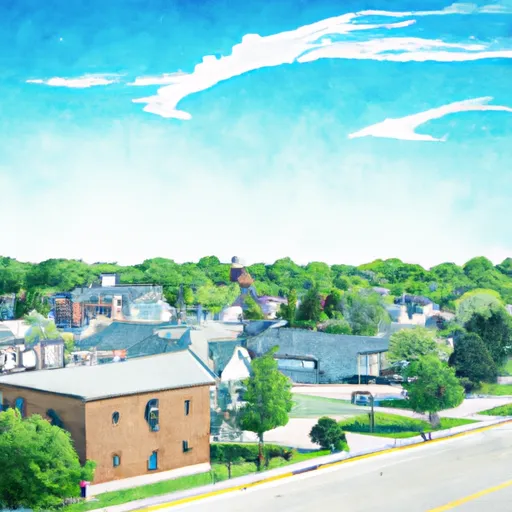-
 Snoflo Premium
Snoflo Premium
Get unlimited access to all our content
With no Ad interruptions! - Start Your Free Trial Login with existing account
West-Olive
Eden Index
Climate
7.7
•
Recreation
4.6
•
Community
3.3
•
Safeguard
5.5/10

West Olive is a small community located in Ottawa County, Michigan. Situated on the eastern shore of Lake Michigan, it experiences a moderate continental climate with warm summers and cold winters. The area enjoys four distinct seasons, with average high temperatures ranging from 30°F (-1°C) in winter to 82°F (28°C) in summer, and annual precipitation averaging around 36 inches (91 cm).
Hydrology constituents in West Olive are primarily influenced by its proximity to Lake Michigan. The area is characterized by sandy soils and dune formations, which contribute to unique ecosystems. Wetlands, marshes, and inland lakes dot the landscape, providing abundant habitat for wildlife and recreational opportunities like fishing, kayaking, and birdwatching. Visitors can explore the nearby Pigeon River State Forest, Holland State Park, and Rosy Mound Natural Area, all of which offer hiking trails, beautiful beaches, and stunning vistas.
Overall, West Olive offers residents and visitors a diverse range of outdoor recreational activities, complemented by its picturesque natural surroundings and the refreshing presence of Lake Michigan.
What is the Eden Index?
The Snoflo Eden Index serves as a comprehensive rating system for regions, evaluating their desirability through a holistic assessment of climate health, outdoor recreation opportunities, and natural disaster risk, acknowledging the profound impact of these factors on livability and well-being.
Climate Health Indicator (CHI): 7.7
West-Olive receives approximately
897mm of rain per year,
with humidity levels near 82%
and air temperatures averaging around
10°C.
West-Olive has a plant hardyness factor of
6, meaning
plants and agriculture in this region thrive during a short period during spring and early summer. Most
plants will die off during the colder winter months.
By considering the ideal temperature range, reliable water supplies, clean air, and stable seasonal rain or snowpacks, the Climate Health Indicator (CHI) underscores the significance of a healthy climate as the foundation for quality living.
A healthy climate is paramount for ensuring a high quality of life and livability in a region, fostering both physical well-being and environmental harmony. This can be characterized by ideal temperatures, reliable access to water supplies, clean air, and consistent seasonal rain or snowpacks.
Weather Forecast
Streamflow Conditions
Southeastern Lake Michigan
Area Rivers
Southeastern Lake Michigan
Snowpack Depths
Southeastern Lake Michigan
Reservoir Storage Capacity
Southeastern Lake Michigan
Groundwater Levels
Recreational Opportunity Index (ROI): 4.6
The Recreational Opportunity Index (ROI) recognizes the value of outdoor recreational options, such as parks, hiking trails, camping sites, and fishing spots, while acknowledging that climate plays a pivotal role in ensuring the comfort and consistency of these experiences.
Access to outdoor recreational opportunities, encompassing activities such as parks, hiking, camping, and fishing, is crucial for overall well-being, and the climate plays a pivotal role in enabling and enhancing these experiences, ensuring that individuals can engage in nature-based activities comfortably and consistently.
Camping Areas
| Campground | Campsites | Reservations | Toilets | Showers | Elevation |
|---|---|---|---|---|---|
| Covert Park | 60 | 658 ft | |||
| Blue Lake County Park | 25 | 670 ft | |||
| Fremont Lake City Park | None | 747 ft | |||
| Shamrock Park | None | 608 ft | |||
| Mississinewa Lake - Miami Recreation Area | 430 | 764 ft | |||
| White River Campground | 106 | 774 ft | |||
| Potato Creek State Park | 290 | 783 ft | |||
| Van Buren State Park | 220 | 642 ft | |||
| Dorner Lake | 8 | 853 ft | |||
| Pines Point | 94 | 717 ft |
Nearby Ski Areas
Catastrophe Safeguard Index (CSI):
The Catastrophe Safeguard Index (CSI) recognizes that natural disaster risk, encompassing floods, fires, hurricanes, and tornadoes, can drastically affect safety and the overall appeal of an area.
The level of natural disaster risk in a region significantly affects safety and the overall livability, with climate change amplifying these risks by potentially increasing the frequency and intensity of events like floods, fires, hurricanes, and tornadoes, thereby posing substantial challenges to community resilience and well-being.
Community Resilience Indicator (CRI): 3.3
The Community Resilience Indicator (CRI) recognizes that education, healthcare, and socioeconomics are crucial to the well-being of a region. The CRI acknowledges the profound impact of these elements on residents' overall quality of life. By evaluating educational resources, healthcare accessibility, and economic inclusivity, the index captures the essential aspects that contribute to a thriving community, fostering resident satisfaction, equity, and social cohesion.

